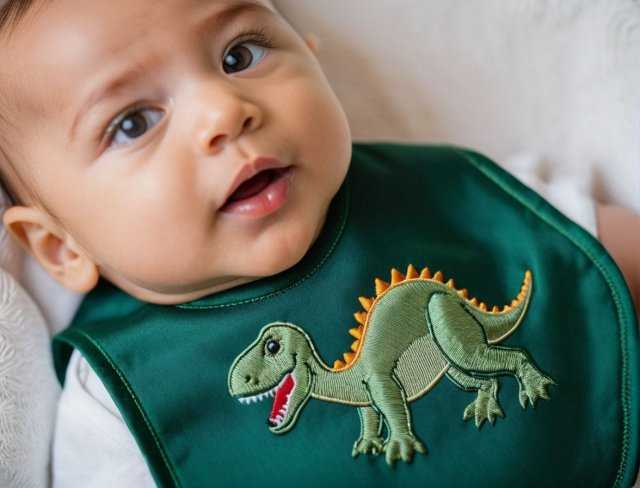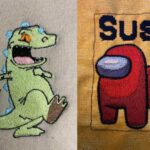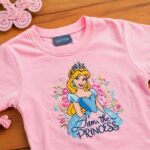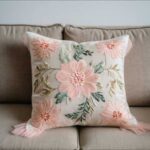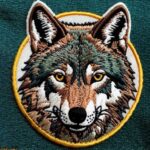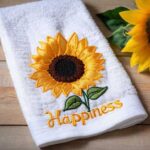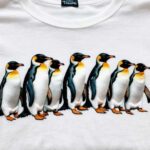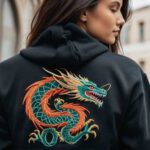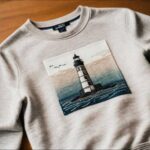Minimize The Mess
An Introduction to Toddler Bib Embroidery
Introduction
Embroidered bibs represent more than just practical mealtime accessories; they embody a world of creativity, comfort, and safety for toddlers and parents alike. From the careful selection of hypoallergenic fabrics to the thoughtful consideration of design elements, each embroidered bib serves as a testament to the love and care woven into every stitch. As toddlers embark on the journey of self feeding and exploration, embroidered bibs become cherished companions, offering both protection from spills and stains and a canvas for personalized expression.
In the realm of bib embroidery, creativity knows no bounds. Whether adorned with whimsical characters, nature inspired motifs, or educational designs, each bib tells a unique story, reflecting the joy, laughter, and milestones of early childhood. Through a harmonious blend of practicality and style, embroidered bibs transform mealtime into a sensory rich experience, fostering curiosity, connection, and comfort for toddlers and their families.
The Significance of Bibs in Toddlerhood
Bibs hold a multifaceted significance in the journey of toddlerhood, serving as both practical tools and symbolic markers of a child’s growth and development. As toddlers transition from infancy to a more independent stage, their mealtime habits evolve significantly, introducing new challenges and opportunities for both the child and the parents.
At the most basic level, bibs are essential for protecting a toddler’s clothing from the inevitable spills and messes that occur during mealtime. Toddlers are naturally curious and eager to explore the world around them, including the various textures and tastes of food. This exploration often leads to messy eating as they develop their fine motor skills and learn to feed themselves. Bibs act as the first line of defense against food stains, reducing the frequency and intensity of laundry loads and preserving the condition of a child’s clothing. This practicality is invaluable for busy parents who seek to minimize the aftermath of mealtime messes.
Beyond their practical utility, bibs symbolize a significant developmental milestone in a child’s life. The transition from bottle feeding or nursing to self feeding is a major step towards independence. During this period, bibs become more than just protective gear; they are symbols of a child’s growing autonomy and self reliance. As toddlers learn to hold utensils, drink from cups, and manage their food, the presence of a bib signifies their participation in the shared social ritual of family meals. It marks their progress from being fed to feeding themselves, a crucial step in their journey toward independence.
The use of bibs also enhances the overall mealtime experience for toddlers. Mealtime can be a sensory rich activity, and a well designed bib can add to this by incorporating vibrant colors, playful patterns, and engaging textures. Embroidered bibs, in particular, can feature a wide array of designs, from favorite animals and characters to personalized names and messages. These visual and tactile elements can make mealtime more enjoyable and engaging for children, turning what might otherwise be a mundane routine into a fun and interactive experience.
The significance of bibs extends to the emotional and social realms as well. Family mealtimes are key opportunities for bonding and communication. As toddlers sit at the table with their family, their bibs help integrate them into this important social practice. Embroidered bibs with personalized elements can reinforce a child’s sense of identity and belonging. When a child sees their name or a favorite motif on their bib, it can provide a sense of pride and ownership, further encouraging positive associations with mealtime.
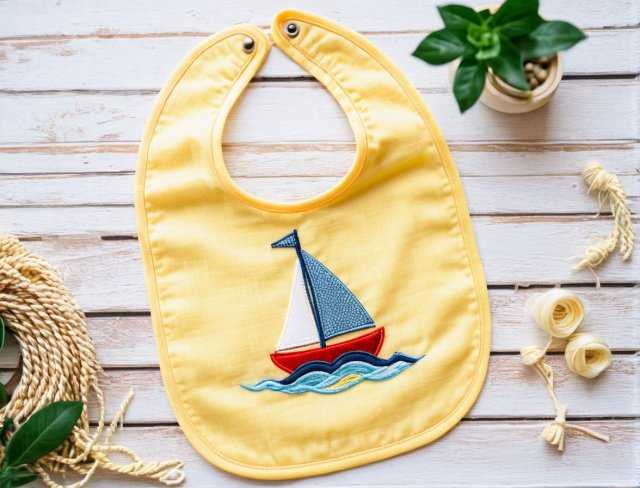
In many cultures, bibs and other infant clothing items are steeped in tradition and cultural significance. Embroidered bibs can reflect cultural heritage through traditional patterns, symbols, and colors. They can also be part of family traditions, passed down from older siblings or customized for each child in the family. These cultural and familial connections add another layer of meaning to the use of bibs in toddlerhood, making them not just practical items, but also carriers of cultural and familial stories.
Using bibs can also be indirectly linked to the development of fine motor skills. As toddlers learn to put on and take off their bibs, they practice important skills like fastening snaps or Velcro strips. These activities, though simple, contribute to their overall motor skill development, coordination, and dexterity. Encouraging children to put on their bibs independently fosters a sense of responsibility and self sufficiency.
Bibs in toddlerhood are far more than mere clothing protectors. They are practical aids that simplify parents’ lives, symbols of growing independence, and enhancers of the mealtime experience. Bibs contribute to a child’s emotional and social development, reflect cultural and family traditions, and even aid in developing fine motor skills. Through their multifunctional role, bibs become an integral part of a toddler’s journey towards independence and self expression, making them a cherished aspect of early childhood.
Parental and Child Benefits
Embroidered bibs offer a multitude of benefits for both parents and children, making them a cherished addition to any household with young children. These benefits extend beyond the obvious practical advantages, touching upon emotional, developmental, and aesthetic aspects that enrich the parent/child experience.
• Parental Convenience: One of the most immediate and tangible benefits of embroidered bibs is the convenience they offer to parents. Toddlers are notoriously messy eaters, and mealtimes can often result in clothes that are stained and require frequent washing. By using bibs, parents can significantly reduce the time and effort spent on laundry. High quality embroidered bibs are designed to absorb spills and resist stains, making them easy to clean and maintain. This practical aspect allows parents to focus more on enjoying mealtime with their child rather than worrying about the aftermath of cleaning up.
• Childhood Keepsakes: Embroidered bibs often serve as more than just protective wear; they become treasured keepsakes that capture the essence of early childhood. Customizing bibs with names, initials, or unique designs can transform a simple bib into a sentimental item. Parents can look back on these personalized bibs with fondness, recalling the special moments of their child’s early years. These keepsakes can be preserved and even passed down as heirlooms, creating a tangible link between generations and a lasting memory of a child’s formative years.
• Expression of Creativity: For parents who enjoy arts and crafts, embroidering bibs offers a creative outlet. Embroidery allows parents to personalize bibs with designs that reflect their child’s personality, interests, and milestones. This creative process can be deeply fulfilling, providing a sense of accomplishment and joy. Moreover, the ability to customize bibs means that each one can be unique, tailored to match the themes of birthdays, holidays, or other special occasions. This personal touch adds an extra layer of meaning to the bibs, making them not just functional items but also expressions of parental love and creativity.
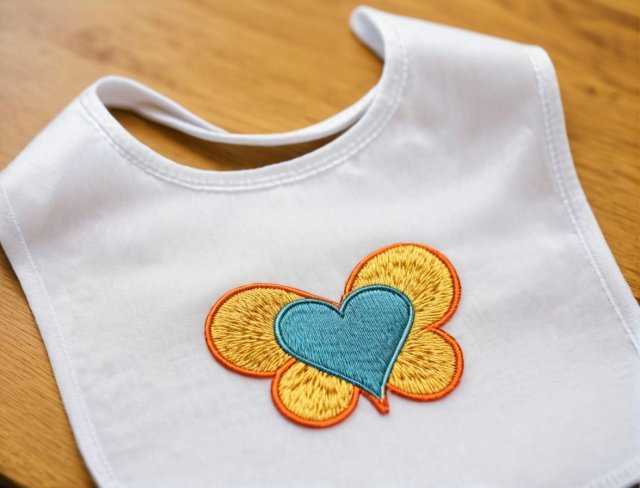
• Enhanced Dining Experience: For children, wearing an embroidered bib can make mealtime more enjoyable and engaging. The bright colors, playful designs, and personalized elements can transform a simple bib into a source of fascination and delight. Children may look forward to wearing their favorite bib, which can help reduce resistance to wearing one during meals. This positive association can make mealtime a more pleasant experience for both the child and the parents. Furthermore, a well designed bib can help a child feel more involved and invested in the mealtime process, fostering a sense of routine and structure.
• Developmental Benefits: Embroidered bibs can also play a role in a child’s development. As children learn to put on and take off their bibs, they practice fine motor skills and hand/eye coordination. These seemingly simple actions contribute to their overall development and independence. Additionally, personalized bibs with the child’s name or favorite designs can support early literacy and recognition skills. Seeing their name embroidered on a bib can help young children recognize and learn to spell their own name, adding an educational dimension to this everyday item.
• Emotional Bonding: The process of choosing, designing, and using embroidered bibs can strengthen the emotional bond between parent and child. Selecting a bib together can be a fun activity, allowing parents and children to share their preferences and make decisions collaboratively. This shared experience can enhance the sense of connection and communication between them. Furthermore, the act of embroidering a bib or choosing a special design can be an expression of a parent’s love and care, reinforcing the emotional ties within the family.
• Fashion and Style: Embroidered bibs add a touch of fashion and style to a child’s wardrobe. Unlike plain bibs, embroidered ones can complement a child’s outfit, adding a stylish flair to their appearance. Parents who appreciate fashion can enjoy the opportunity to accessorize their child’s attire with bibs that match or enhance their clothing. This attention to detail can make everyday activities like eating at home or dining out feel more special and coordinated.
Embroidered bibs offer numerous benefits that enhance the lives of both parents and children. They provide practical advantages by simplifying cleanup and reducing laundry, serve as cherished keepsakes, offer a creative outlet for parents, and enrich the mealtime experience for children. Additionally, they support a child’s developmental milestones, strengthen emotional bonds, and add a touch of style to daily routines. Through their multifunctional role, embroidered bibs become an integral part of the early parenting experience, blending practicality with personal expression and joy.
Fabrics of Bib Embroidery
The choice of fabric for bib embroidery plays a crucial role in determining the quality, comfort, and durability of the finished product. When selecting fabrics for toddler bibs, it is essential to consider factors such as softness, absorbency, hypoallergenic properties, and ease of care. Each fabric type brings unique qualities to the table, enhancing both the functional and aesthetic aspects of the embroidered bibs.
Cotton
Cotton is one of the most popular choices for bib embroidery, and for good reason. Known for its softness and breathability, cotton is gentle on a toddler’s delicate skin, reducing the risk of irritation or discomfort. The natural fibers of cotton make it highly absorbent, capable of soaking up spills and drools effectively, which is essential during mealtime. Additionally, cotton is easy to clean and can withstand frequent washing without losing its shape or softness, making it a practical choice for everyday use.
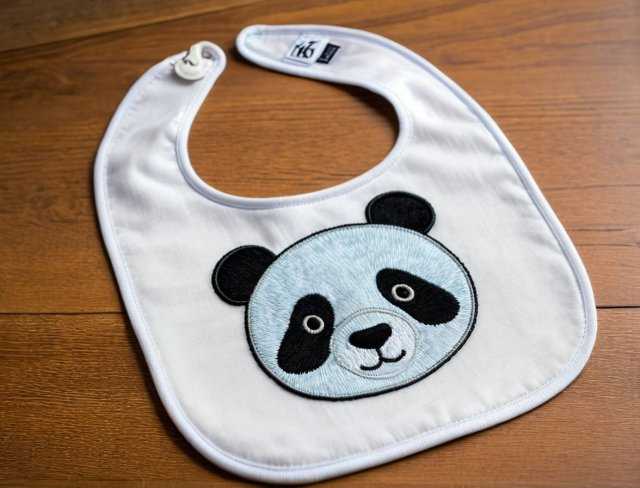
High quality cotton fabrics, such as Egyptian cotton or organic cotton, offer even greater softness and durability. Organic cotton is particularly appealing to parents who are concerned about environmental sustainability and the potential exposure of their children to pesticides and chemicals used in conventional cotton farming. These higher grade cotton fabrics ensure that the bibs remain soft and comfortable for the child, even after multiple washes.
Terry Cloth
Terry cloth is another favored option for bib embroidery, especially for parents looking for superior absorbency. Made from cotton or a cotton blend, terry cloth features looped piles that increase its surface area, enhancing its ability to absorb liquids. This plush texture makes terry cloth bibs excellent at handling spills and messes, keeping the child dry and comfortable during mealtime.
The softness of terry cloth also adds a layer of comfort for the child, while its durability ensures that the bibs can withstand rough handling and frequent laundering. Terry cloth is particularly suitable for infants and young toddlers who are prone to drooling and spitting up, providing a reliable barrier against moisture. Additionally, terry cloth is available in a variety of colors and patterns, allowing for creative and attractive embroidered designs.
Bamboo Fabric
Bamboo fabric has gained popularity in recent years as an eco friendly and hypoallergenic option for bib embroidery. Bamboo is a sustainable resource, growing rapidly without the need for pesticides or fertilizers, making it an environmentally responsible choice. The natural antibacterial and antimicrobial properties of bamboo fabric help to reduce odors and keep the bibs fresh between washes.
One of the standout features of bamboo fabric is its incredible softness. Often compared to silk or cashmere, bamboo fabric is exceptionally smooth and gentle on sensitive skin, making it ideal for babies and toddlers with allergies or skin sensitivities. Bamboo fabric is also highly absorbent and breathable, ensuring that the child remains comfortable and dry during mealtime.
In addition to its practical benefits, bamboo fabric lends a luxurious feel to embroidered bibs, elevating them from simple accessories to stylish and sophisticated items. The combination of sustainability, comfort, and quality makes bamboo fabric an excellent choice for parents seeking the best for their children.
Polyester Blends
Polyester blends, often combined with cotton or other natural fibers, are another option for bib embroidery. These blends can offer the best of both worlds, combining the softness and absorbency of natural fibers with the durability and stain resistance of synthetic materials. Polyester blends are known for their strength and resilience, making them suitable for bibs that need to endure heavy use and frequent washing.
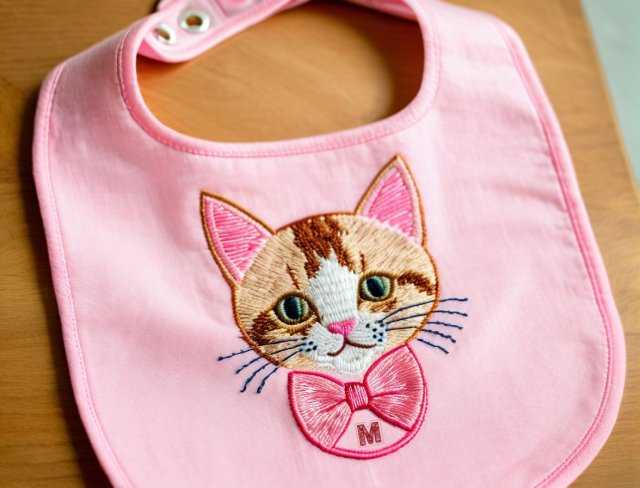
While not as breathable as pure cotton or bamboo, polyester blends can still provide a comfortable and practical solution for embroidered bibs. They are less prone to shrinking and wrinkling, maintaining their appearance and functionality over time. Additionally, polyester blends can be more affordable, providing a cost effective option for parents looking to create multiple embroidered bibs.
Muslin
Muslin, a lightweight and loosely woven cotton fabric, is another excellent choice for bib embroidery. Muslin is known for its breathability and softness, making it comfortable for toddlers to wear during mealtime. The airy nature of muslin allows it to dry quickly, which can be particularly useful for bibs that need to be washed and reused frequently.
Muslin bibs are gentle on the skin and can be layered for added absorbency, making them versatile and functional. They are also easy to embroider, as the fabric provides a stable base for intricate designs. Muslin’s simplicity and elegance lend a timeless quality to embroidered bibs, making them a favorite among parents who appreciate both functionality and aesthetics.
Fleece
Fleece, a synthetic fabric made from polyester, is another option for bib embroidery, particularly for cold weather. Fleece is known for its softness, warmth, and moisture wicking properties, making it suitable for bibs used in cooler climates. The fabric is lightweight yet durable, providing a comfortable barrier against spills and dribbles.
Fleece is easy to care for and resists staining, making it a practical choice for parents who want low maintenance bibs. While it may not be as breathable as natural fibers, fleece can be combined with other materials, such as cotton, to enhance its functionality and comfort. The plush texture of fleece adds a cozy element to embroidered bibs, making them both functional and comforting for the child.
The selection of fabric for bib embroidery plays a crucial role in determining the overall quality and effectiveness of the finished product. Whether opting for the softness and breathability of cotton, the absorbency of terry cloth, the eco friendliness of bamboo, the durability of polyester blends, the lightweight nature of muslin, or the warmth of fleece, each fabric offers unique benefits that cater to different needs and preferences. By carefully considering factors such as fabric quality, softness, hypoallergenic properties, and ease of care, parents can choose the best materials for creating comfortable, stylish, and functional embroidered bibs for their toddlers.
Materials Needed
Embarking on a bib embroidery project requires a few essential materials to ensure successful and satisfying results. From specialized equipment to quality supplies, having the right materials on hand is key to creating beautiful and functional embroidered bibs for toddlers. Here are the essential materials needed for your bib embroidery endeavor:
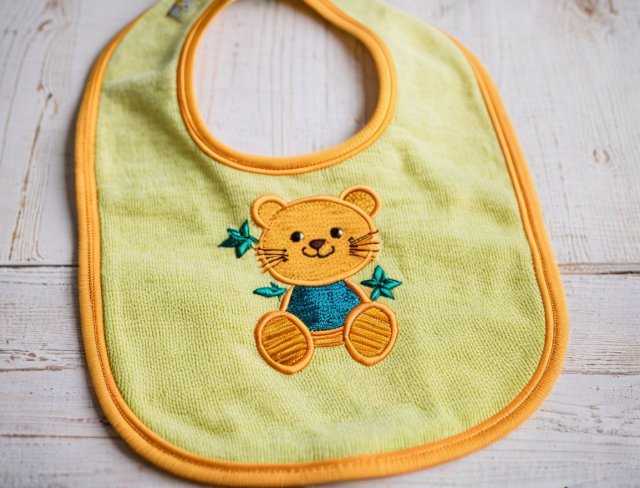
• Embroidery Machine: The cornerstone of any embroidery project is the embroidery machine itself. Whether you opt for a traditional sewing machine with embroidery capabilities or invest in a dedicated embroidery machine, having the right equipment is essential for achieving precise and professional results. Embroidery machines come in various models and price ranges, offering a range of features such as builtin designs, color touchscreen displays, and multiple hoop sizes. Choose a machine that suits your skill level, budget, and project requirements, ensuring that it can handle the type of embroidery you intend to do, whether it’s simple monograms or intricate designs.
• Embroidery Threads: High quality embroidery threads are essential for creating vibrant and long lasting designs on bibs. Choose threads that are specifically designed for machine embroidery, as they are more durable and resistant to fraying than standard sewing threads. Polyester and rayon threads are popular choices for their sheen, colorfastness, non-toxic, and strength. Select a range of colors to match your design palette and add visual interest to your embroidered bibs. It’s also a good idea to invest in thread storage solutions to keep your threads organized and easily accessible during embroidery projects.
• Stabilizers: Stabilizers are support materials that help prevent fabric puckering and distortion during embroidery. They provide stability to the fabric, allowing for smoother stitching and more precise designs. There are various types of stabilizers available, including tear away, cut away, and water soluble stabilizers, each suited to different fabric types and embroidery techniques. Choose the appropriate stabilizer based on the fabric and design complexity of your bibs, ensuring that it provides adequate support without interfering with the finished embroidery.
• Digitized Designs: Digitized designs serve as templates for machine embroidery, guiding the stitching process and determining the final appearance of the design. You can create your own digitized designs using embroidery software or purchase predigitized designs from reputable sources online. When selecting digitized designs for bib embroidery, consider factors such as design complexity, stitch count, and compatibility with your embroidery machine. Opt for designs that are well suited to the size and shape of your bibs, ensuring that they fit comfortably within the embroidery hoop and result in crisp and clear stitching.
• Embroidery Hoops: Embroidery hoops are essential tools for securing fabric in place during embroidery, ensuring smooth and even stitching. Choose hoops that are appropriately sized for the bibs you plan to embroider, allowing for ample space around the design area. Adjustable hoops are ideal for accommodating different fabric thicknesses and shapes, while magnetic hoops offer added convenience and stability. When hooping your bibs, ensure that the fabric is taut and wrinkle free to achieve optimal embroidery results.
• Scissors and Snips: Sharp scissors and snips are indispensable tools for trimming threads, cutting stabilizers, and tidying up embroidered designs. Invest in high quality embroidery scissors with fine, pointed tips for precision cutting, as well as snips with spring loaded handles for easy one handed operation. Having multiple pairs of scissors on hand allows you to quickly switch between thread colors and tackle different cutting tasks without interrupting your embroidery workflow.
• Marking Tools: Marking tools such as fabric markers, chalk pencils, and water soluble pens are essential for transferring design outlines onto your bibs. Choose marking tools that are easily visible on your fabric yet removable after embroidery to avoid any residual marks. Test the marking tools on a scrap piece of fabric to ensure they are compatible with your chosen bib fabric and embroidery thread colors. Additionally, consider using embroidery software or templates to accurately position and align your designs on the bibs before stitching.
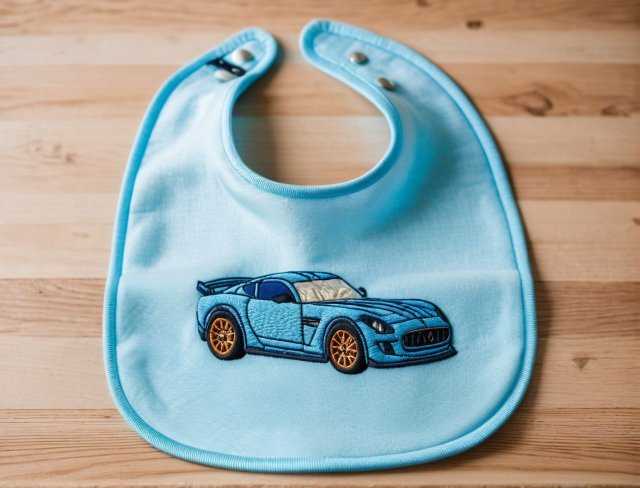
• Bobbins and Bobbin Thread: Bobbins and bobbin thread are necessary for winding and loading the bottom thread into your embroidery machine. Use pre wound bobbins or wind your own bobbins with high quality bobbin thread that matches your embroidery thread colors. Proper tension and thread tension adjustments ensure smooth and consistent stitching throughout your embroidery projects. Keep a sufficient supply of bobbins and bobbin thread on hand to avoid interruptions during embroidery and to maintain consistent thread tension.
• Fabric for Bibs: Finally, choose high quality fabric for your bibs that is soft, absorbent, and durable enough to withstand repeated washing and wear. Cotton, terry cloth, bamboo fabric, and polyester blends are popular choices for bibs due to their comfort, absorbency, and ease of care. Select fabric colors and patterns that complement your embroidery designs and reflect the preferences of the intended recipient. Pre wash and pre shrink your fabric before embroidering to prevent any distortion or shrinkage after stitching.
Gathering the right materials is essential for successful bib embroidery projects. From embroidery machines and threads to stabilizers and marking tools, having a well stocked embroidery toolkit ensures smooth and satisfying results. By investing in quality materials and paying attention to detail, you can create beautiful and functional embroidered bibs that are sure to delight toddlers and parents alike.
Creative Ideas
When it comes to bib embroidery, the possibilities for creativity are endless. From whimsical designs to personalized touches, there are countless ways to transform plain bibs into unique and eye catching accessories for toddlers. Here are some creative ideas to inspire your next bib embroidery project:
Embroidered Characters: Bring beloved characters to life by embroidering them onto bibs. Whether it’s classic storybook characters, favorite cartoon animals, or popular superheroes, embroidered characters add a playful and imaginative touch to bibs. Choose designs that resonate with the child’s interests and preferences, creating bibs that are as fun to wear as they are functional.
Nature Inspired Motifs: Capture the beauty of the natural world with nature inspired motifs such as flowers, animals, and landscapes. Delicate floral patterns, whimsical woodland creatures, and scenic vistas can adorn bibs, adding a touch of organic charm and tranquility. Consider incorporating seasonal elements like leaves in the fall, snowflakes in the winter, and blooming flowers in the spring to reflect the changing seasons.
Personalized Monograms: Add a personal touch to bibs by embroidering the child’s initials or name onto them. Monogrammed bibs not only make practical gifts but also serve as cherished keepsakes that commemorate special occasions such as birthdays, baby showers, and holidays. Choose elegant fonts and decorative motifs to enhance the monogram’s visual appeal, creating custom designed bibs that are as stylish as they are sentimental.
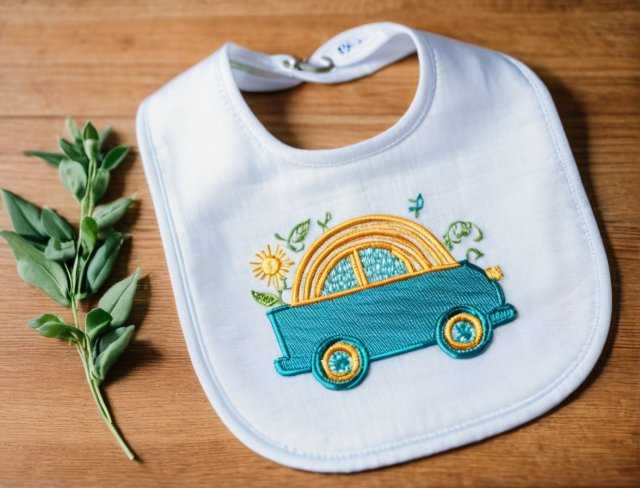
Themed Collections: Create themed collections of bibs inspired by specific motifs, colors, or events. Whether it’s a nautical theme with sailboats and anchors, a farm theme with barnyard animals and tractors, or a holiday theme with festive symbols and motifs, themed collections offer endless possibilities for creativity. Coordinate the designs, colors, and patterns across the bibs to create cohesive sets that are perfect for gifting or personal use.
Educational Designs: Combine learning and fun with educational designs that promote early childhood development. Embroider letters, numbers, shapes, and colors onto bibs to introduce toddlers to basic concepts in a playful and interactive way. Incorporate interactive elements such as Velcro shapes or zipper pockets that allow children to practice fine motor skills while wearing their bibs. Educational bibs not only make mealtime more engaging but also provide valuable learning opportunities for young children.
Holiday and Special Occasion Themes: Celebrate holidays and special occasions with themed bibs that capture the spirit of the season. Whether it’s Halloween with spooky ghosts and pumpkins, Christmas with jolly Santas and reindeer, or birthdays with festive balloons and confetti, holiday themed bibs add a festive touch to mealtime festivities. Customize bibs with embroidered messages or motifs that commemorate milestones such as first birthdays, first holidays, and other memorable occasions.
Gender Neutral Designs: Opt for gender neutral designs that appeal to a wide range of tastes and preferences. Choose versatile colors such as pastels, earth tones, or primary colors that are suitable for both boys and girls. Select motifs and patterns that are age appropriate and universally appealing, avoiding stereotypical gender themes. Gender neutral bibs are not only practical for families with multiple children but also promote inclusivity and diversity in early childhood fashion.
Interactive Elements: Add interactive elements to bibs that engage and entertain toddlers during mealtime. Incorporate sensory features such as textured fabrics, crinkly materials, or hidden squeakers that stimulate the senses and encourage exploration. Attach removable toys or teethers to bibs using Velcro or snaps, providing toddlers with additional entertainment and distraction during meals. Interactive bibs turn mealtime into a sensory rich experience that promotes curiosity, creativity, and cognitive development.
Bib embroidery offers a world of creative possibilities for designing unique and personalized accessories for toddlers. Whether it’s embroidered characters, nature inspired motifs, personalized monograms, themed collections, educational designs, holiday themes, gender neutral designs, or interactive elements, there are endless opportunities to showcase your creativity and imagination. With a little inspiration and innovation, you can create one of a kind bibs that delight toddlers and parents alike, turning mealtime into a fun and fashionable affair.
Safety Considerations
Ensuring the safety of embroidered bibs is paramount, especially when they are intended for use by young children. From the choice of materials to the construction methods, every aspect of bib embroidery should prioritize safety and comfort. Here are some important safety considerations to keep in mind:
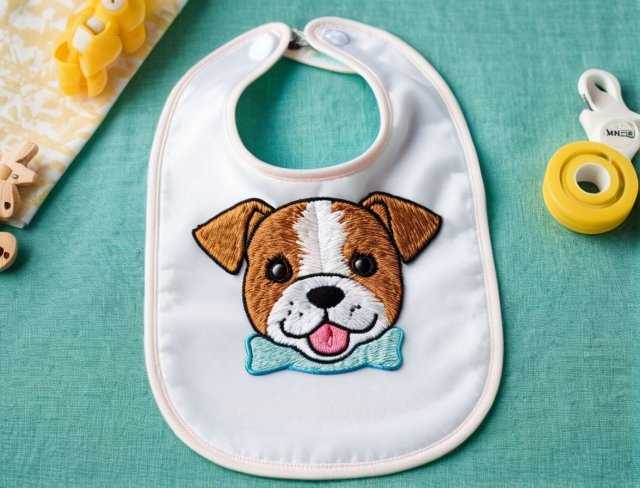
• Hypoallergenic Materials: When selecting fabrics and threads for bib embroidery, opt for hypoallergenic materials that are gentle on a child’s sensitive skin. Natural fibers such as cotton, bamboo, and organic cotton are ideal choices for bibs, as they are soft, breathable, and less likely to cause allergic reactions or skin irritations. Avoid synthetic materials that may contain harsh chemicals or irritants, opting instead for natural and organic options that prioritize the child’s well being.
• Nontoxic Dyes and Inks: Choose nontoxic dyes and inks for embroidering designs onto bibs, ensuring that they are safe for prolonged contact with a child’s skin and mouth. Look for water based or eco friendly dyes that are free from harmful chemicals and heavy metals. Test the dyes and inks on a small, inconspicuous area of the fabric to ensure they are colorfast and do not bleed or fade over time. Prioritize the health and safety of the child by using only certified safe and nontoxic materials in your embroidery projects.
• Secure Embroidery Techniques: Employ secure embroidery techniques that minimize the risk of loose threads or embellishments coming loose and posing a choking hazard to young children. Double check the tension and stitch density of your embroidery machine to ensure that threads are securely fastened to the fabric. Trim any excess threads or jump stitches carefully to prevent them from becoming entangled or detached during use. Reinforce high stress areas such as edges and seams with additional stitching or backstitching to enhance durability and longevity.
• Avoid Small Parts and Embellishments: Avoid using small parts or embellishments that could detach from the bib and pose a choking hazard to young children. Steer clear of buttons, beads, sequins, or other decorative elements that may come loose and be ingested by curious toddlers. Instead, opt for flat or embroidered designs that are securely stitched onto the fabric and do not present a choking risk. Prioritize safety over aesthetics when designing embroidered bibs for toddlers, ensuring that they meet rigorous safety standards and guidelines.
• Machine Washable and Easy to Clean: Choose machine washable fabrics and threads that are easy to clean and maintain, ensuring that bibs remain hygienic and free from bacteria and germs. Select fabrics that can withstand frequent washing and drying without shrinking, fading, or losing their shape. Pre shrink fabrics before embroidering to minimize the risk of distortion or shrinkage after laundering. Use colorfast threads that retain their vibrancy and integrity even after repeated washings, maintaining the quality and appearance of embroidered bibs over time.
• Comfort and Fit: Prioritize comfort and fit when designing embroidered bibs for toddlers, ensuring that they are soft, lightweight, and non restrictive. Choose fabrics that feel gentle against the skin and allow for freedom of movement during mealtime activities. Avoid bulky or stiff materials that may cause discomfort or irritation, opting instead for fabrics with a smooth texture and drape. Pay attention to the design and construction of bibs to ensure they provide adequate coverage and protection without overwhelming or constricting the child.
• Breathability and Airflow: Promote airflow and breathability in embroidered bibs to prevent overheating and discomfort during wear. Choose fabrics with a loose weave or open knit that allow for optimal ventilation and moisture wicking. Avoid heavy or densely woven materials that trap heat and moisture against the skin, increasing the risk of irritation and heat rash. Prioritize breathable fabrics that keep the child cool and comfortable, even during extended periods of wear.
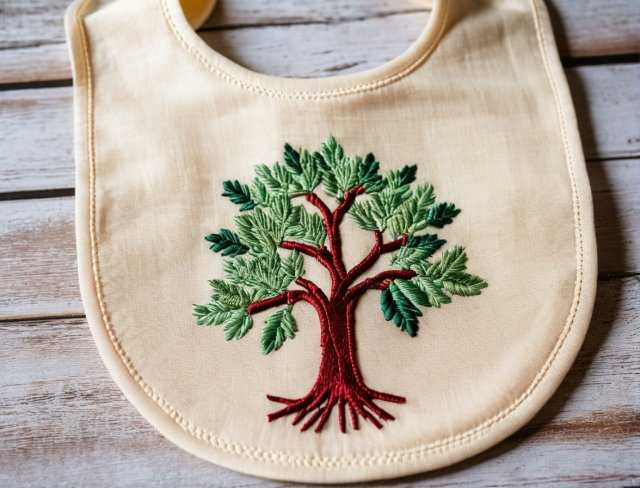
Safety should be the top priority when designing and embroidering bibs for toddlers. By selecting hypoallergenic materials, using nontoxic dyes and inks, employing secure embroidery techniques, avoiding small parts and embellishments, choosing machine washable fabrics, prioritizing comfort and fit, and promoting breathability and airflow, you can create embroidered bibs that are not only stylish and functional but also safe and comfortable for young children to wear.
Conclusion
Bib embroidery offers a delightful fusion of practicality, creativity, and safety for toddlers and their caregivers. Through the careful selection of hypoallergenic fabrics and nontoxic materials, embroidered bibs become more than just mealtime accessories; they serve as cherished keepsakes, promoting a sense of comfort and security for both children and parents. The creative possibilities are endless, from whimsical characters to educational motifs, allowing for personalized expressions of love and joy that enhance the mealtime experience and foster early childhood development.
As toddlers navigate the journey of self feeding and exploration, embroidered bibs stand as symbols of independence and growth, providing a touch of style and sophistication to everyday routines. With a focus on safety considerations and comfort, embroidered bibs become treasured companions on the adventure of toddlerhood, encouraging curiosity, creativity, and connection between parent and child. In the world of bib embroidery, every stitch tells a story, weaving together moments of laughter, learning, and love that leave a lasting impression on the hearts and minds of families everywhere.
Now that you have read through this article, feel free to SHOP for products we have created. If you are looking for something special which isn’t in our store, feel free to contact us.

